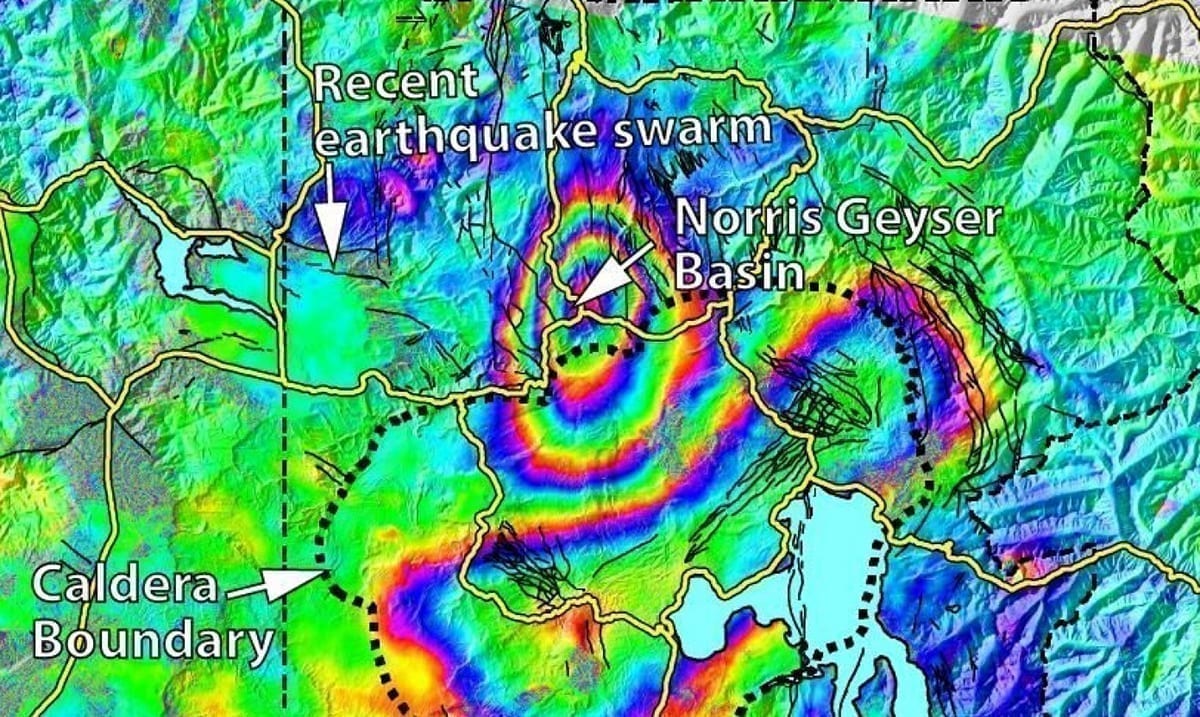Once again we’re seeing a lot of seismic activity at and around Yellowstone. While we see earthquakes in places like this quite often, the number of quakes being found is even now interesting to learn about.
Now, for those who do not know Yellowstone is a super-volcano. This meaning it has seriously dangerous potential. Super-volcanos are volcanos that have in the past had an eruption of magnitude 8. If some kind of ‘super’ eruption were to happen here in the US from Yellowstone, tons of lives would be lost, and well, nothing would ever be the same with our planet.
Breaking down what a super-volcano is the USGS wrote as follows:
The term “supervolcano” implies a volcanic center that has had an eruption of magnitude 8 on the Volcano Explosivity Index (VEI), meaning the measured deposits for that eruption is greater than 1,000 cubic kilometers (240 cubic miles). The VEI scale was created as a general measurement of the explosivity of an eruption. There are multiple characteristics used to give an eruption its VEI allowing for the classification of current and historic eruptions. The most common criteria are volume of ejecta (ash, pumice, lava) and column height. All VEI 8 eruptions occurred tens of thousands to millions of years ago making the volume of ejecta or deposits the best method for classification. An eruption is classified as a VEI 8 if the measured volume of deposits is greater than 1,000 cubic kilometers (240 cubic miles). Therefore a supervolcano is a volcano that at one point in time erupted more than 1,000 cubic kilometers of deposits. Yellowstone, like many other supervolcanoes, has also had much smaller eruptions. The cartoon shows a comparison of eruption sizes, including the three largest from Yellowstone. Click on the image for a more detailed description and larger view.
Now, while 100 earthquakes in a month sounds intense it’s really not necessarily that serious. Most of these earthquakes were likely so small they weren’t even felt and we see swarms like this quite often. Actually, Yellowstone itself according to Forbes saw around 300 in May alone. Yellowstone is one of the most seismically active areas in the US that there is and well, this kind of thing is to be expected. The area itself tends to have up to 8,000 earthquakes each year and well, most are tiny.
Despite the number of earthquakes found, Yellowstone according to the USGS remains at green/normal. Just because something sounds like a big deal doesn’t mean it is. This area is used to earthquakes like these and we’re probably going to be facing more of them this month as well. I know, the idea of the ground shaking near a volcano is scary, especially when that volcano is Yellowstone but do keep in mind this kind of thing is being monitored.
The USGS said as follows on the seismic activity for June c:
The University of Utah seismograph stations which was responsible for the operation and maintenance of the Yellowstone seismic network located 102 earthquakes in the Yellowstone region during the month of June. That’s pretty normal for the region where we see typically about 1500 to 2500 earthquakes every year on average. So in fact, we’re sort of on the low side of average this month. Now, the largest earthquake of the month occurred on June 5th, mountain time about 10 miles south of Man of Hot Springs. That was a magnitude of 2.8. There was also a small swarm of about 17 events that occurred between June 12th and the 15th oh, about halfway between Norris Junction and West Yellowstone. So a pretty average month for earthquakes in the Yellowstone region. Now if we zoom out and look at the greater region you can see that there are continued aftershocks of the tectonic earthquake that occurred on March 31st in central Idaho. So these are not related to Yellowstone but are aftershocks as the fault system there continues to settle following that major magnitude six event. There are also some aftershocks from the magnitude five event that occurred in mid-March in the Salt Lake City area. You can see there are many fewer aftershocks. Of course, the larger the earthquake the longer the aftershock sequence will last. So since this was sort of a mid-five in the Salt Lake City area, the aftershock sequence is already calming down. Now, this was a mid-six-event in the Idaho area. That aftershock sequence is still quite vigorous and we’ll expect it to continue being vigorous for several months, but calming down gradually over time.
As noted above the worst of those quakes was a mere 2.8 magnitude. To learn more about Yellowstone itself take a look at the video below. While these earthquakes aren’t something to be freaking out over at the moment, that volcano in itself is a true terror when you really understand what it’s capable of.

